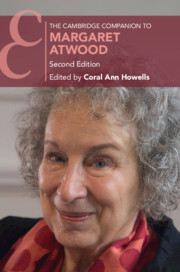32 results
Chapter 11 - Margaret Atwood’s Recent Dystopias
-
-
- Book:
- The Cambridge Companion to Margaret Atwood
- Published online:
- 19 March 2021
- Print publication:
- 01 April 2021, pp 171-188
-
- Chapter
- Export citation
Note on Editions Used
-
- Book:
- The Cambridge Companion to Margaret Atwood
- Published online:
- 19 March 2021
- Print publication:
- 01 April 2021, pp xv-xv
-
- Chapter
- Export citation
Preface
-
- Book:
- The Cambridge Companion to Margaret Atwood
- Published online:
- 19 March 2021
- Print publication:
- 01 April 2021, pp xiii-xiii
-
- Chapter
- Export citation
Abbreviations
-
- Book:
- The Cambridge Companion to Margaret Atwood
- Published online:
- 19 March 2021
- Print publication:
- 01 April 2021, pp xvi-xvii
-
- Chapter
- Export citation
Copyright page
-
- Book:
- The Cambridge Companion to Margaret Atwood
- Published online:
- 19 March 2021
- Print publication:
- 01 April 2021, pp iv-iv
-
- Chapter
- Export citation
Further Reading
-
- Book:
- The Cambridge Companion to Margaret Atwood
- Published online:
- 19 March 2021
- Print publication:
- 01 April 2021, pp 206-212
-
- Chapter
- Export citation
Introduction
-
-
- Book:
- The Cambridge Companion to Margaret Atwood
- Published online:
- 19 March 2021
- Print publication:
- 01 April 2021, pp 1-13
-
- Chapter
- Export citation
Index
-
- Book:
- The Cambridge Companion to Margaret Atwood
- Published online:
- 19 March 2021
- Print publication:
- 01 April 2021, pp 213-216
-
- Chapter
- Export citation
Acknowledgments
-
- Book:
- The Cambridge Companion to Margaret Atwood
- Published online:
- 19 March 2021
- Print publication:
- 01 April 2021, pp xiv-xiv
-
- Chapter
- Export citation
Margaret Atwood Chronology
-
- Book:
- The Cambridge Companion to Margaret Atwood
- Published online:
- 19 March 2021
- Print publication:
- 01 April 2021, pp xviii-xxii
-
- Chapter
- Export citation
Contents
-
- Book:
- The Cambridge Companion to Margaret Atwood
- Published online:
- 19 March 2021
- Print publication:
- 01 April 2021, pp vii-viii
-
- Chapter
- Export citation
Notes on Contributors
-
- Book:
- The Cambridge Companion to Margaret Atwood
- Published online:
- 19 March 2021
- Print publication:
- 01 April 2021, pp ix-xii
-
- Chapter
- Export citation
Dedication
-
- Book:
- The Cambridge Companion to Margaret Atwood
- Published online:
- 19 March 2021
- Print publication:
- 01 April 2021, pp v-vi
-
- Chapter
- Export citation

The Cambridge Companion to Margaret Atwood
-
- Published online:
- 19 March 2021
- Print publication:
- 01 April 2021
9 - Writing by Women
-
-
- Book:
- The Cambridge Companion to Canadian Literature
- Published online:
- 26 May 2017
- Print publication:
- 27 May 2017, pp 217-238
-
- Chapter
- Export citation
5 - Alice Munro and her life writing
-
-
- Book:
- The Cambridge Companion to Alice Munro
- Published online:
- 05 March 2016
- Print publication:
- 08 March 2016, pp 79-95
-
- Chapter
- Export citation
PART FIVE - WRITING IN FRENCH
-
- Book:
- The Cambridge History of Canadian Literature
- Published online:
- 28 September 2010
- Print publication:
- 05 November 2009, pp -
-
- Chapter
- Export citation
Index
-
- Book:
- The Cambridge History of Canadian Literature
- Published online:
- 28 September 2010
- Print publication:
- 05 November 2009, pp 706-753
-
- Chapter
- Export citation
PART ONE - OLD AND NEW WORLD, LA NOUVELLE-FRANCE, THE CANADAS, DOMINION OF CANADA
-
- Book:
- The Cambridge History of Canadian Literature
- Published online:
- 28 September 2010
- Print publication:
- 05 November 2009, pp -
-
- Chapter
- Export citation
Frontmatter
-
- Book:
- The Cambridge History of Canadian Literature
- Published online:
- 28 September 2010
- Print publication:
- 05 November 2009, pp i-xlviii
-
- Chapter
- Export citation



